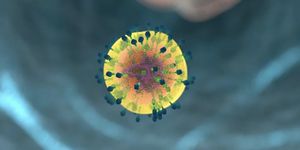Playing "Tag" with the Immune System
Human cells employ an intricate tagging system to manage protein activity in the body. By “tagging” a protein with a certain modification, cells can control the diverse physiological mechanisms of day-to-day operation.
One such “tag” was first discovered in 1975 for its role in protein degradation. Known as ubiquitin, this protein tag is now associated with many other functions in the body, such as regulating homeostasis; dysfunction of ubiquitin is associated with neurodegenerative disorders.
Researchers from the present study sought to uncover modification sites of an immune protein tag with many similarities to ubiquitin, called ISG15. Ubiquitin and ISG15 attach to target proteins in a similar fashion, and consequently, products of proteins tagged with ISG15 “display the same tag” as products of proteins modified by ubiquitin.
Unlike ubiquitin, however, ISG15 is activated only in cases of stress, namely during the immune response to bacterial and viral infections. Possibly because of ISG15’s selective activation, scientists have struggled to pinpoint the identity and location of ISG15-modified proteins. Ubiquitin and ISG15 proved similar enough, though, for researchers from the present study to use the same technology used to study ubiquitin to identify ISG15 modification sites.
Researchers developed a mice model of listeria (Listeria monocytogenes) to study ISG15 activity. They analyzed liver samples for signs of ISG15 activity, as the liver is an organ involved in metabolism and filtering blood of microbes. Ultimately, they discovered almost 1,000 ISG15 binding sites on more than 400 protein targets during the course of the listeria infection.
Many of the enzymes found to be involved in the ISG15 pathway are associated with metabolic processes and autophagy. Involvement in autophagy indicates that ISG15 could be harnessed for antibacterial therapeutic solutions, a finding deemed significant by the research team. Researchers already investigating ISG15 in the context of other infections like influenza and Coxsackie virus, a virus that belongs to the same family as poliovirus and is a leading cause of aseptic meningitis.
Sources: The Flanders Institute for Biotechnology, Nature Communications, International Journal of Molecular Sciences








